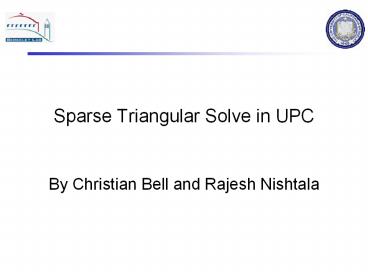Sparse Triangular Solve in UPC - PowerPoint PPT Presentation
Title:
Sparse Triangular Solve in UPC
Description:
A common but irregular mathematical operation occurring in linear algebra is the ... A new style of programming for an old problem ... – PowerPoint PPT presentation
Number of Views:61
Avg rating:3.0/5.0
Title: Sparse Triangular Solve in UPC
1
Sparse Triangular Solve in UPC
- By Christian Bell and Rajesh Nishtala
2
Motivation
- A common but irregular mathematical operation
occurring in linear algebra is the Sparse
Triangular Solve (SpTS). - Solve for x in Tx b where T is a lower
triangular sparse - Used after sparse Cholesky or LU factorization to
solve sparse linear systems - Irregularity arises from dependence
- Hard to parallelize
- dependence structures only known at runtime
- must effectively build dependence tree in
parallel
3
Algorithm Description
- To solve for x in Tx b (T is lower triangular)
- for r1n
- x(r) b(r)
- for c1r
- x(r) x(r) - T(r,c)x(c)
- Key takeaways
- To solve xr you depend on all values of x before
it - rows can be partially solved by knowing which
values of xc are valid
4
Dependency Graph
Matrix
Dependence Graph
5
Data Structure Design
- Allow more startup time analysis of matrix so
that the solve is faster - Build the dependence graph in parallel
- Support O(1) lookup during solve time
- O(1) operations made easy by UPC
6
Solve Methodology
- Producer / Consumer Relationship
- consume x vector in Tx b to produce a new xj
variable. - production causes generation of signal to every
processor waiting on xj - Difficult with two-sided model of MPI
- allows you to effectively leverage one-sided
communication available in UPC - Avoid synchronization
- by knowing a priori what part of other threads
address space you can safely write into. - very difficult to get right through MPI
7
Performance (1)
8
Performance (2)
9
Conclusions and Future Work
- A new style of programming for an old problem
- Leverage one-sided messaging not easily available
in MPI - Integrate into libraries such as SuperLU































